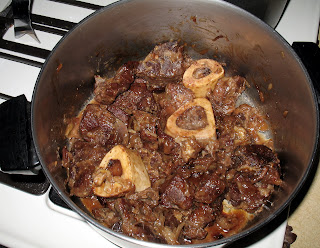After that, we tied up a “bouquet garni”, with a small piece of muslin and some thread, containing three cloves of garlic, the zest of half an orange, five whole cloves, and a bay leaf. That way you can pull the whole bundle out when the dish is finished and don’t have to wonder who will bite down on a whole clove in their gravy!
We had three options for cooking the casserole: in a large “Dutch oven” on the stovetop, in a casserole in the oven, or in a crockpot. We chose the stovetop method, although the oven or crockpot would have required less tending. We also had a choice of cooking liquid: dark beer or full-bodied red wine. We chose the former: two bottles of Negra Modelo.
We used a little beer to deglaze the frying pan before combining the meat, the onions, the bouquet garni and the rest of the beer, along with salt and pepper, in a six-quart Dutch oven. Use something non-reactive (stainless steel, oven-proof glass, glazed ceramic, enamel-coated cast iron such as Le Creuset), whenever the dish contains an acid, like beer or wine or a vinegar sauce.
We brought it to a boil and then turned the heat down until the liquid was just barely simmering, and let it cook two to three hours until the meat was very tender. If you cook it in the oven, do so on slow heat (250 degrees F.), and on low if in a crock pot, for as many hours as a similar meat dish would cook.
When the chunks were tender, we fished out the herb bag and the bones. Then we scooped the marrow out of the bones, and stirred it back into the sauce to enrich it; the marrow melts right in. If most of the liquid has cooked away, and the onion turned to jam, you can thin it a little if you want a sauce or gravy. If it is too juicy, you can thicken it with a little cornstarch or potato flour mixed with a little water. Adjust salt and pepper to your taste.
The orange peel and cloves combined with the natural sugars in the onion produce a pleasant and slightly sweet casserole, which we enjoyed. If it doesn’t sound good to you, omit the orange and switch the cloves to juniper berries (the recipe called for these, but we didn’t have any on hand) or a splash of gin. For other variations, use red wine instead of beer, or add a little cognac or whiskey in the final sauce. Serve over noodles or mashed potatoes. We had it with noodles and green peas.
Next, we’ll return to the rich beef stock. And then on to the pork pie.





No comments:
Post a Comment